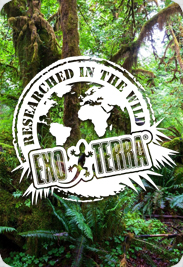Spedizione 2005 - Uganda / Il diario
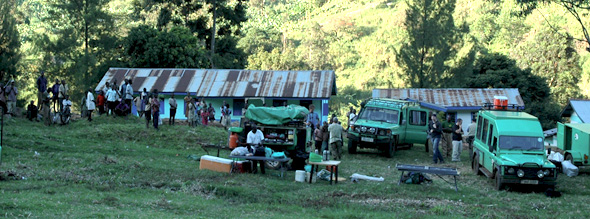
Itinerary
Day 01 - Dec 5th: Brussels - Entebbe
Day 02 - Dec 6th: Kisubi – Kibale Forest National Park
Day 03 - Dec 7th: Kibale Forest & Bigodi swamps
Day 04 - Dec 8th: Kibale Forest – Rwenzori Mountains
Day 05 - Dec 9th: Rwenzori Mountains
Day 06 - Dec 10th: Rwenzori Mountains
Day 07 - Dec 11th: Rwenzori Mountains - Maramagambo Forest
Day 08 - Dec 12th: Maramagambo Forest
Day 09 - Dec 13th: Maramagambo Forest– Ishasha
Day 10 - Dec 14th: Ishasha – Bwindi Impenetrable Forest
Day 11 - Dec 15th: Bwindi Impenetrable Forest
Day 12 - Dec 16th: Bwindi Impenetrable Forest
Day 13 - Dec 17th: Bwindi Impenetrable Forest
Day 14 - Dec 18th: Bwindi Impenetrable Forest – Lake Bunyonyi
Day 15 - Dec 19th: Lake Bunyonyi – Brussels
Day 1, Monday, Dec. 5, 2005
Brussels – Entebbe
The Exo Terra Uganda Expedition left Brussels at 10h35 bound for Kampala, Uganda. After a 9-hour flight, the team arrived at Entebbe International Airport around 22h50 local time. It took another 3 hours to clear immigration and customs, which caused us to arrive late at Kisubi, our first campsite. Kisubi, located on the shore of Lake Victoria, is only 10 km (6.2 miles) from Entebbe.

Our Ugandan team members had already set up the campsite and erected the tents. Upon our arrival they welcomed us with a fine meal. Exhausted and well-fed, it did not take us long before we were ready to hit our sleeping bags.
Some of the hard-core team members could not resist the call of the millions of frogs near Lake Victoria and went off to examine the shore plants and reeds by flashlight. The first “herpetological” discovery was a reed frog, Hyperolius viridiflavus found in the vegetation along the lakeshore. We also came across the common African toad, Bufo regulari. The need for sleep, however, soon forced even these die-hard explorers to take to their beds. All of us were eager to see what Lake Victoria, the source of the Nile, looked like by daylight.
Day 2, Tuesday, Dec. 6, 2005
Kisubi – Kibale Forest National Park
Even before sunrise, the first of the tents flapped opened in order for us to catch the first glimpse of the legendary Lake Victoria in the morning light. In some places, fog patches covered parts of the lake; whereas in others, the first sunrays delicately coloured the waters in hues of pink and orange.
After breakfast we packed up camp and headed to the Kibale Forest National Park. The trip to this unique forest, located in western Uganda, took almost 9 hours. Along the way, the scenic beauty of Uganda was revealed to us for the first time. We took a short lunch break by the side of the road, during which time we experienced our first wildlife sighting – a group of black and white Colobus Monkeys off in the distance. On a nearby termite hill, we spotted and photographed a tree agama, Acanthocerus atricollis, basking in the sun.
We stopped for another short break in Fort Portal, where we were able to stock up on supplies before heading into the rainforest.
Arriving at our destination, Bigodi, we established camp. This is where we would be spending the next two nights. Bigodi is located near the Kibale Forest National Park, which was established as a national park in 1993. Currently approximately 766 square kilometers (296 square miles) are protected. The Kibale Forest National Park is primarily a moist evergreen forest, a transition between lowland rain forest and montain rain forest. However, a variety of habitats including swamp, grassland, woodland and thicket are also present in the park. Rainfall is typically concentrated during two distinct wet seasons, March through May and September through November. The average annual maximum temperature measured at Kanyawara is 23.3 °C (74 °F) while the average annual minimum temperature is 16.2 °C (61°F).

After sunset we started our search for nocturnal amphibian and reptile species. On this night armed guards accompanied us as we walked through the dense forest, since forest elephant and forest buffalo are abundant in this area. These are sub-species of the savannah elephant and buffalo, but are considered to be more dangerous and aggressive. Most of the snakes are active after dusk, especially the African rock python (Python sebae) and the vipers (Atheris sps. and Bitis nasicornis), but unfortunately we were not able to find any of these and turned back to the campsite after a couple of hours. We made sure to arrange for the armed guards to accompany us again the next evening.
Day 3, Wednesday, Dec. 7, 2005
Kibale Forest & Bigodi swamps
Early the next morning we left the base camp for Kanyanchu, a field station within the forest. Scientists from the Makerere University use this field station, and the vast network of trails found in this part of the forest, to research the many primate species.
We were looking for the four chameleon species that have been recorded in the Kibale Forest; Bradypodion adolfifriderici, Chamaeleo ellioti, C. ituriensis and Rhampoleon boulengeri. Unfortunately it started raining in the early morning and it did not stop until late at night, making it almost impossible to spot any reptiles at all.
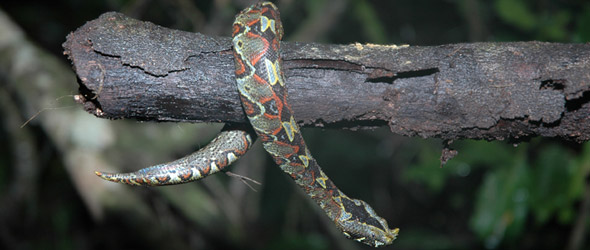
The only, but very interesting, find was the colourful rhinoceros viper, Bitis nasicornis - one of the many poisonous snakes of Uganda and definitely one of the most beautiful. Even our guide was surprised at this find, since the last time she saw this type of snake was when she was 5 years old. This should give you some indication as to the rarity of the species. However, no other reptiles or amphibians were seen that day. The only other excitement we had during this 8-hour walk through the dense rainforest was encountering of a group of chimpanzees. The group was high in the trees and the weather conditions did not allow us to get a good view, let alone take decent pictures. We had a late lunch back at the Kanyanchu field station where we waited for sunset.
At dusk we entered the forest, again with the armed guards, to continue our search for reptiles and amphibians. Luckily it had stopped raining, but again we were not able to find anything except for the common frog Ptychadena mascareniensis at the edge of the forest. That night we gave up our night walk after one hour and returned to the camp. There, our Ugandan team mates surprised us with a massive buffet of Congolese and Ugandan specialties. They had planned this buffet to celebrate the birthday of three of our team members: Michael, Noah and Oliver. The Ugandan service crew even managed to bring a birthday cake with their names on it all the way from Entebbe.
This was a welcome treat after a long, rainy, unsuccessful day of reptile spotting and we all went satisfied to our tents.
Day 4, Thursday, Dec. 8, 2005
Kibale Forest – Rwenzori Mountains
The next day got off to a promising start -- a spotless blue sky! In the trees next to our tents we spotted many blue-headed tree agamas (Acanthocerus atricollis), already basking in the sun to make up for yesterday’s showers. In the early morning we explored the wetlands and marshes behind our camp in Bigodi. The swamp edge was dense thicket, alternating with papyrus. In the trees we could see red colubus monkeys and many colourful birds, including African grey parrots. A male Adolfus africanus was found basking on a tree trunk. And then finally a pair of Chameleo ellioti. The male had a striking pattern of orange and blue, while the female was almost entirely green. The pair was found in a small tree about 2 m (6 ft) above the ground. A thorough search in the same area revealed another pair, also on a small isolated tree, indicating that the species live in pairs, which is remarkable for chameleons. While stopping off at a bar to buy a warm soda, we noticed a pair of small house geckos (Hemidactylus mabouia) on the bar’s ceiling.

From here we traveled back to Fort Portal where we had lunch and re-stocked supplies. After lunch we traveled to Nyakalengija, in the Rwenzori Mountains, to set up a base camp. While setting-up we were greeted by hundreds of villagers, curious to see what we were up to. Once set-up we immediately started an initial scouting expedition in search of the Johnston’s Chameleons (Chamaeleo johnstoni) and the much rarer Strange-horned Chameleon (Bradypodion xenorhinum), but without success. Everyone went to bed early in preparation for the big hike the next day into the mountains.
The Rwenzori Mountains define the north-eastern border between the Congo and Uganda. They give rise to tall jagged peaks, the highest of which is the 16,795-foot (5,119 m) Margherita Peak. These famed “Mountains of the Moon” receive up to 350 days of rain per year, producing thick mists that drift through the moss-laden trees. It is a true mountain range, created by the up-lift of the earth’s crust through tectonic movement, and not as a result of volcanic activity. The range is 120 km (74.5 miles) in length and 48 km (30 miles) in width. The mountains are frequently shrouded in mist and cloud, with the peaks rarely being visible from far. At the center of the range, there are six peaks carrying permanent snow, three with glaciers. The highest of these peaks, and the third highest peak in Africa, is Mt. Margherita rising 5102 meters (16738 ft) above sea level.
The Rwenzori Mountains were declared a National Park in 1991. The park covers 996 square kilometers of rugged mountain terrain and is home to chimpanzees, giant forest hogs, forest elephants and many unique reptile and bird species. In comparison to the other vertebrate groups the number of endemic reptiles is relatively low, with 11 strict endemics. These include four species of chameleons and four species of skinks (the genus Leptosiaphos). Despite its high biological importance, much of the forest of this area remains poorly studied. Specific references on the biodiversity of the Rwenzori Mountains are rare. It is suspected that additional reptile and amphibian endemics are present in these mountain forests.
Day 5, Friday, Dec. 9, 2005
Rwenzori Mountains
After breakfast we inquired about getting some porters to help us carry the heavy gear and equipment up the hill. Everything was carefully weighed on a meat scale to ensure that we did not overload the porters. The weight limit for each porter was 25 kg (55 lbs) each, which considering the nature of the climb, was a lot!

After passing the Uganda Wildlife Authority office in the village we started our ascent to the Nyabitaba hut. From the village, it was still a forty minute walk to reach the Rwenzori National Park boundary. Once within the park, the trail follows the Mubuku River. This first leg of our mountain expedition involved crossing recent landslide areas, and climbing over rocks and bluffs, before reaching the Mahoma River after about 3 hours. The temperature had reached 35 °C (95°F) by noon, which made the climbing even more difficult. After crossing the Mahoma River the terrain got steeper, through open bracken fern slopes and the Podorcarpus Forest. Again guards, armed with Kalashnikovs to ensure our safety, accompanied us. Huge numbers of forest elephants cross the trail periodically. It took us another 4 hours to finally reach the Nyabitaba hut (2652 m/8700 ft), an ascent of more than 1200 m (3937 ft). It was only when we were almost at the hut that we found the rare Strange-horned Chameleon (Bradypodion xenorhinum), at an altitude where we had expected to see the even rarer Carpenter’s chameleon (Bradypodion carpenteri). Even extensive searches near the hut by the team members and local trackers did not reveal this very rare chameleon. Exhausted from the climb we all went to bed early and skipped the planned night search. The metal “garden shed” graced with the name the Nyabitaba hut, in which all 11 of us had to sleep, made for an interesting night’s accommodation.
Day 6, Saturday, Dec. 10, 2005
Rwenzori Mountains
After a good night’s sleep everyone was refreshed. First we documented and photographed the Strange-horned Chameleon we found the day before. We had kept the chameleon overnight in an Exo Terra Explorarium which we hung outside the hut. After the photo-shoot, we began our second day of exploration and the descent back to Nyakalengija. The decent normally takes a few hours, but we planned to take all the time needed to thoroughly search for chameleons and other reptiles.
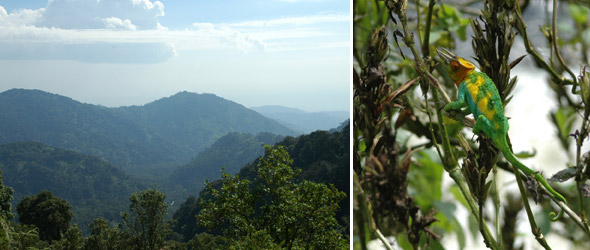
We planned to head back in the afternoon but a stay overnight at Nyakalengija was expected. It took us less than an hour to find a female Strange-horned Chameleon (Bradypodion xenorhinum), and shortly after a young male. The next discovery was an unbelievably coloured Johnston’s Three-horned Chameleon (Chameleo johnstoni) -- greens, blues, yellows, even a red-orange head. The animal was spotted near the river, down a steep slope, and we had to form a human chain to capture it in order to properly document and photograph this magnificent animal. While we were all busy admiring its beauty, and taking tons of pictures, a porter found the female in a nearby bush. Although hornless, the females are almost as stunning and colourful as the males. We now were close to the Mahoma bridge, about two-thirds of the distance to Nyakalengija. We did not see many reptiles from this point on down, except for a basking Adolfus africanus and a pair of Chamaeleo ellioti.
It was already late afternoon when we arrived at our base camp and again the village children welcomed us. This time they even tried to sell us chameleons (!) which they captured nearby. Most of them were the rare Bradypodion xenorhinum, indicating that the population is not all that small. We discouraged the children from catching any more chameleons by not accepting them or offering money. Near the camp we were able to photograph a weird looking Adolfus sp. and a stunning blue-headed tree agama in the late afternoon sun. We had an early supper and celebrated our successful Rwenzori expedition around a huge campfire. We all went to our tents long before the villagers were ready to turn in, at least as far as we could judge by the loud music down the hill. But after all it was Saturday night!
Day 7, Sunday, Dec. 11, 2005
Rwenzori Mountains - Maramagambo Forest
After saying goodbye to the 30 people that accompanied us into the mountains the day before, as well as the other villagers, we left with our convoy to travel to the Maramagambo Forest in Queen Elizabeth National Park via Kasese. We stopped briefly in this charming town to buy some supplies and refuel the Jeeps. A little later we crossed the equator and arrived at the Kasese plains near the border of Lake George. The change in climate and habitat was amazing, from tropical rainforest to the typically dry African savannah in just one hour. Venturing far from the vehicles to search for the herpetofauna was too dangerous because of the incredible amount of wildlife, including buffalos, elephants and lions! While we were photographing a Nile Monitor (Varanus niloticus), a herd of about 30 elephants appeared from down hill.
Getting out of the vehicles to search the thicket for chameleons was out of the question. We proceeded slowly and continued our search from within the safety of the jeeps. In addition to elephants, we encountered various species of antelope; herds of buffalo; warthogs and giant forest hogs. We hoped to see some of the many snakes that can be found here, such as the Spitting Cobra (Naja nigricollis) or the Puff Adder (Bitis arietans), but none were seen.
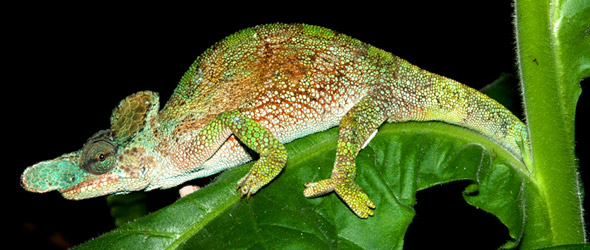
We had lunch in Mweya near the Kazinga Channel where we chartered a boat to explore the shores of the channel. Kazinga Channel connects Lake George and Lake Eduard. Aside from big game such as hippos; buffalos; elephants and bushbucks, we found our first Nile Crocodile (Crocodylus niloticus) basking on the sandy shoreline. Wildlife near the channel was very abundant and it was amazing to even find a small fishing village with a lot of activity near the shoreline -- humans living in harmony with all these animals. Still, we decided to stay in the boat. We returned late to Mweya and had to rush to our new camp at the edge of Maramagambo Forest near Nyamusingiri. By the time we arrived at the campsite, way after sunset, our service team members had juicy steaks waiting for us on an improvised grill hung over the campfire. A great meal, after an even more amazing day.
Day 8, Monday, Dec. 12, 2005
Maramagambo Forest
This is one of the largest forests in Uganda and is the last mediumaltitude, moist semi-deciduous woodland in East Africa. The name of the forest referes to its vastness and means “‘the one who is traveling in the forest is empty of words”. Interspersed within the forest are a number of tranquil crater lakes and caves. The forest extends to the southern tip of the Queen Elizabeth National Park, the so-called Ishasha sector, named after the river bordering the Democratic Republic of Congo.

After breakfast we left the camp, accompanied by armed guides, to one of the caves in the forest. It took us about 2 hours before we reached the entrance to the cave. The cave was home to thousands of Egyptian bats which could be heard - and smelled - from some distance away. In the cavities at the bottom of the cave we found an African Rock Python (Python sebae), strangling and eating a bat. As we proceeded deeper into the cave, we found more pythons – lurking and ready to snatch an errant bat. Meanwhile, hundreds of bats were flying in and out the cave bumping into us every second. When we emerged from the cave, the entire team was covered in tiny mites, luckily they were harmless to humans. We had also hoped to find the Black Forest Cobra (Naja melanoleuca) here, preying on bats, but did not find any. We also explored another cave in the forest, called the Hunter Cave, but aside from a few bones and skulls nothing was discovered in there. There was an abundance of birds, but no reptiles were found in the forest. The night walk also did not reveal any spectacular amphibians or reptiles.
Day 9, Tuesday, Dec. 13, 2005
Maramagambo Forest – Ishasha
The next morning we continued our way south, to the most southern tip of the Queen Elizabeth National Park known as the Ishasha sector. It took us about 3 hours to drive through beautiful savannah land before reaching the shores of the Ishasha River. We saw huge concentrations of game, mainly large herds of Uganda Kobs, Topi and Buffalo. We set up our campsite right on the riverbank, in a small forest. If it was not for the hippos in the water, one could easily wade through the river to the Congo. But even though we just observed them from the riverbank, the hippos still charged us several times.
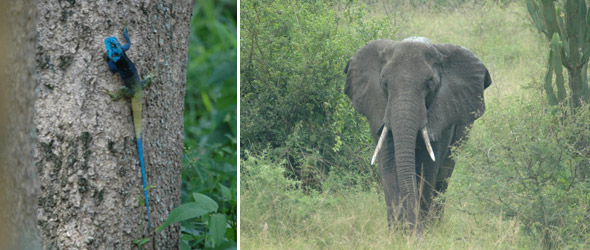
Only a very limited amount of reptile research has been conducted here, and we would focus on Chamaeleo bitaeniatus and geckos like Homopholis fasciata and Lygodactylus gutturalis. After the camp was set up, we left by vehicle to the higher surrounding savannah plains in search of the reptile fauna. It was soon obvious that it also was best to stay in the vehicles, since we soon spotted a lioness in the high grass. Her three cubs were high up in the nearby trees. The trees and thickets were too close to each other to exit the vehicles at this side of the park, so we decided to drive to another area with less dense vegetation and where we had a good overview of the surrounding area. It did not take long before we found our first daygecko, Lygodactylus gutturalis, on a very small tree. Further research indicated the species was very abundant here since at least one, and sometimes a pair, were found on almost every tree. Larger trees, such as the fig trees, probably harboured larger populations. In our search for geckos we found another species of chameleon for the first time; Chameleo bitaeniatus. This species is only found in the higher savannah areas, mainly in Acacia trees. On our way back to the camp we had a great chance to photograph the lion cubs we spotted previously. The mother had disappeared and was probably hunting.
When we returned to camp at dusk, the hippos were very active. Their loud calls could be heard from far away. We had dinner overlooking the Congo, the river and its hippos. Afterwards we explored the area around our tents, before the hippos emerged from the water. We were lucky to find a young forest gecko, Cnemaspis quattuorseriata on a tree trunk. We all went to bed with the knowledge that the hippos might wander through our campsite that night and it took us a while to fall asleep.
Day 10, Wednesday, Dec. 14, 2005
Ishasha – Bwindi Impenetrable Forest
A sudden explosion of loud roars and growls woke us up just before dawn. The hippos, grazing nearby, had provided us with their version of a “wakeup call”. Once the sun rose, the noisy hippos returned to the water and we could break down the campsite. After breakfast we had an early morning game drive over the plains of Ishasha in the open savannah in the hopes of seeing more typical savannah species. The temperature reached 38.5 °C (101°F) by 10 am, the highest recorded on the expedition. Except for a herd of elephants, the regular antelopes and buffalos, we did not see much -- so we decided to head for the Bwindi Impenetrable Forest, some 45 km (28 miles) south.
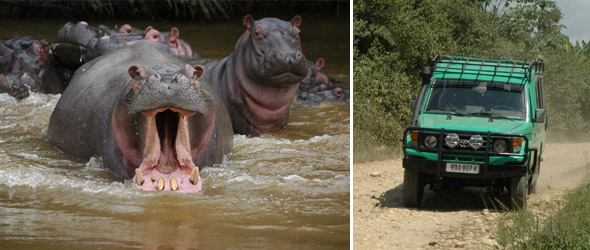
We set up the camp at the edge of the rainforest, again a completely different environment than the open savannah. We supported the local Buhoma village community by using their services and campsite. The cold beer and hot showers were more than welcome! The team relaxed that afternoon and prepared to “penetrate” the Impenetrable Forest the next day. This also gave the service team a day off, since the locals provided most of the services.
Day 11, Thursday Dec. 15, 2005
Bwindi Impenetrable Forest
The forest is located in the most south-western tip of Uganda, high on the edge of the western Rift Valley on the Rukiga Highlands. Its borders are flanked by the Congo and adjacent to the Virunga volcanoes. Because of its range and size, and due to the fact that it includes both mountain and lowland forests, the species diversity is extremely high. A large number of plants and animals are common to this region.
Bwindi Impenetrable Forest is a natural World Heritage site because of its gorilla population. Half of the world’s mountain gorilla population is found in Bwindi (the remainder roam between the Congo, Rwanda and Uganda in the Virunga Conservation area). Vegetation is typical tropical rainforest with very dense undergrowth. The Bwindi Impenetrable Forest offers one of the richest ecosystems in Africa.
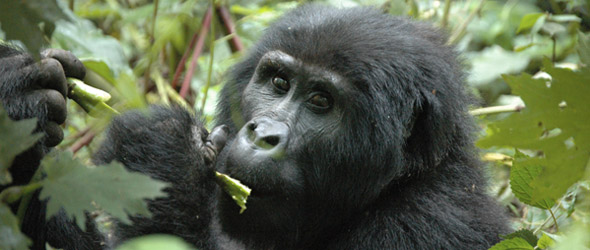
Scarcely 320 square kilometres, Bwindi Impenetrable National Park lives up to its name; slopes are very steep, the vegetation along trail edges can be extremely dense, and much of the central part of the forest is almost inaccessible. The forest proper contains a number of aquatic habitats including three different kinds of swamps, several large rivers, many creeks and a few trails.
After breakfast we got a short briefing from the Uganda Wildlife Authority in case we encountered gorillas in the forest. After the briefing, some armed guards and guides joined us to guarantee our safety. Afterall, it was as recent as 1999 that Congolese and Rwandan rebels killed eight foreigners. We drove about an hour to a remote entry point in the northern sector. Once we entered the forest its name became clearer and clearer. Among the species we expected to encounter were the Smooth Chameleon (Chamaeleo adolfifriderici), the Western Rift Dwarf Chameleon (Rhampholeon boulengeri), the Forest Gecko (Cnemaspis quattuorseriata), the highly venomous Forest Vine Snake (Thelotornis kirtlandi) and Nitsche’s Bush Viper (Atheris nitschei). But before we knew it, we were eye to eye with a huge silverback Mountain Gorilla. This huge male was surrounded by a harem of females, some younger males and a lot of baby gorillas. It was a thrilling moment to be so close to one of our closest relatives. We spent almost one hour with them before continuing our search for reptiles and amphibians. After the false alarm of spotting a snake (it was a huge earthworm), we finally found a chameleon. It was probably one of the rarest species in this part of the world; the Smooth Chameleon, Chamaeleo adolfifriderici. It was a gravid female and attempts to locate its male counterpart failed. Except for the male Chameleo ellioti, and the Adolfus jacksoni near the campsite, we did not find any other herpetofauna that day.
Day 12, Friday, Dec. 16, 2005
Bwindi Impenetrable Forest
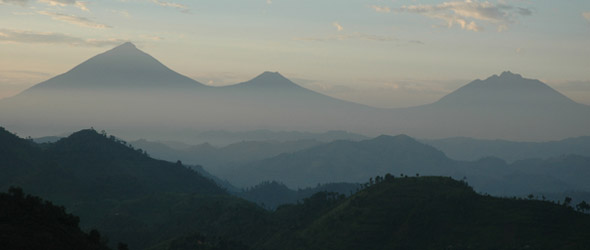
We had to leave Buhoma early, since we had to drive all the way around the Bwindi Impenetrable Forest following a winding mountainous path. In the southern higher part of the forest we were more likely to encounter higher altitude species such as the Chamaeleo rudis, Chamaeleo johnstoni and several bush vipers like the Atheris nitschei. The journey took us about 9 hours along the Ruhija route to Nkuringo, only a few kilometres from the Congolese and Rwandan borders. We stopped at several interesting locations for a short search but were unsuccessful. We arrived at Nkuringo in the late afternoon, after passing by scenic places of terraced hills and mountains. Again we used a campsite made by the local community. It surely was the remotest location of all, surrounded by fabulous views of the Bwindi Impenetrable Forest and the Virunga Volcanoes. One of these volcanoes is at the three-country point joining Uganda, Rwanda and the Congo. The villagers made us a campfire near the community hut, which we gathered around after dinner. Tired from the drive, we went to bed early that night.
Day 13, Saturday, Dec. 17, 2005
Bwindi Impenetrable Forest

Next morning we all woke up early, and we found our first Johnston’s Chameleon even before breakfast! It was the most stunning Chameleo johnstoni with blue eyes. While one of us was taking pictures, other members of the team were already finding additional chameleons. We finally decided to stop searching and focus our efforts on taking decent pictures of several male and female Johnston’s Chameleons. The population of these chameleons was extremely high, and we even found a duelling pair of males tangled together with their horns. Some team members left to explore the forest edges, while others improved their photographic skills near the campsite. By sunset we were all satisfied with the pictures we were able to shoot. After discussing world politics near a huge campfire, we all went to bed way too late.
Day 14, Sunday, Dec. 18, 2005
Bwindi Impenetrable Forest – Lake Bunyonyi
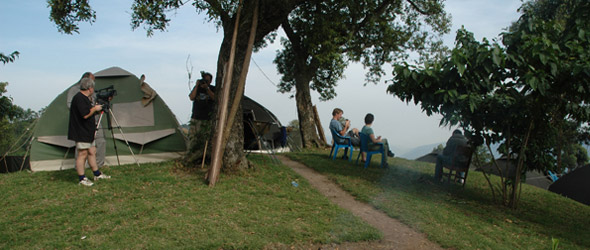
It was with mixed feelings that we left Bwindi that morning. Departing from Bwindi meant that we were starting the journey back home. The route back again took us along winding roads, through mountains and valleys, which lead to remote villages on the outskirts of the Bwindi Impenetrable Forest until we reached the main road near Muko at Lake Bunyonyi. This is the deepest crater lake in Africa, and the deepest lake in Uganda. It was a big surprise to the team members that the last night was in a resort-type bungalow overlooking the lake. It was as if we arrived back in civilization: hot showers, real beds, cold drinks and even a restaurant! We even forgot about looking for reptiles, at least some of us. While the hardcore reptile “freaks” still were looking in the reeds for snakes and frogs, others were taking a dive into the refreshing lake or enjoying the last day with a cold Nile Lager.
Day 15, Monday, Dec. 19, 2005
Lake Bunyonyi – Brussels
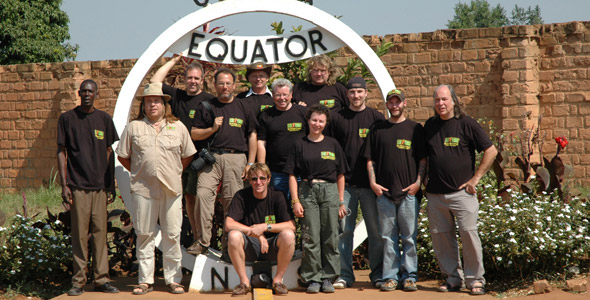
Lake Bunyonyi was a heavenly spot and it was with great difficulty that we tore ourselves away and started our drive back to Kisubi near Lake Victoria. It was about an 8 hour drive to Kisubi, where we were able to refresh ourselves after a long journey and have our last meal together in Uganda. Around 9 pm we left the shore of Lake Victoria for the Entebbe airport, where our departure flight with SN Brussels Airlines was waiting. We arrived back at Brussels Airport on December 20th, at 06h05 local time. Tired, but satisfied, the expedition members all went their separate ways -- bringing back great memories, incredible pictures and tons of knowledge and experience.


